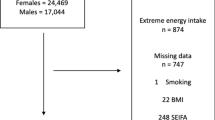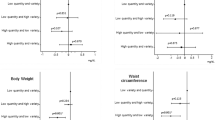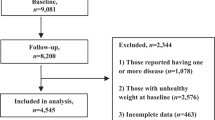Abstract
Objective: To assess the number of portions of fruit and vegetables consumed daily by a large representative sample of older men, and to determine how blood antioxidant (vitamins E, A and carotenoids) concentrations vary with fruit and vegetable consumption.
Design: Cross-sectional study of free-living men.
Subjects: Men aged 55–69 y (dietary data, n=1957; blood data, n=1874) participating in Phase III (1989–1993) of the Caerphilly and Speedwell Collaborative Heart Disease Studies.
Methods: Dietary data were obtained by semi-quantitative food-frequency questionnaire and blood samples were analysed for antioxidant vitamins. Men were subdivided into groups on the basis of portions per day of fruit and vegetables. Within these sub-groups, mean and 95% ranges of intakes and of blood antioxidant levels were obtained. Log transformations were performed where appropriate.
Results: Only 4.3% of the men met the recommended target of five portions, while 33.3% of the men consumed one or fewer portions of fruit and vegetables per day. Those men who consumed the poorest diets with respect to fruit and vegetable intakes were more likely to be from lower socio-economic classes, drink more alcohol and be current smokers. Fruit and vegetable intake reflected plasma concentrations of antioxidants, which showed a dose–response relationship to frequency of consumption.
Conclusions: Older men in the UK consume much less fruit and vegetables than current recommendations. Major difficulties are likely to be encountered in trying to meet a dietary target that is clearly much higher than the fruit and vegetable consumption of large sections of the older population in the UK.
Sponsorship: This work was supported by the Medical Research Council.
European Journal of Clinical Nutrition (2000) 54, 828–833
This is a preview of subscription content, access via your institution
Access options
Subscribe to this journal
Receive 12 print issues and online access
$259.00 per year
only $21.58 per issue
Buy this article
- Purchase on Springer Link
- Instant access to full article PDF
Prices may be subject to local taxes which are calculated during checkout
Similar content being viewed by others
Author information
Authors and Affiliations
Contributions
Guarantor: JJ Strain.
Contributors: JJS was the chief investigator and MRC grant-holder; PCE was MRC grant-holder, had overall responsibility for the Caerphilly Study and helped to write the paper; AD carried out the statistical analysis; OK carried out the laboratory analysis during tenure as MRC research assistant; JC helped with laboratory analysis and writing the paper; AF was responsible for dietary fieldwork; CWM helped in interpretation of laboratory results and writing the paper; PJR helped in interpretation of dietary data and writing the paper; DIT was MRC grant-holder and helped to write the paper.
Corresponding author
Rights and permissions
About this article
Cite this article
Strain, J., Elwood, P., Davis, A. et al. Frequency of fruit and vegetable consumption and blood antioxidants in the Caerphilly cohort of older men. Eur J Clin Nutr 54, 828–833 (2000). https://doi.org/10.1038/sj.ejcn.1601101
Published:
Issue Date:
DOI: https://doi.org/10.1038/sj.ejcn.1601101



